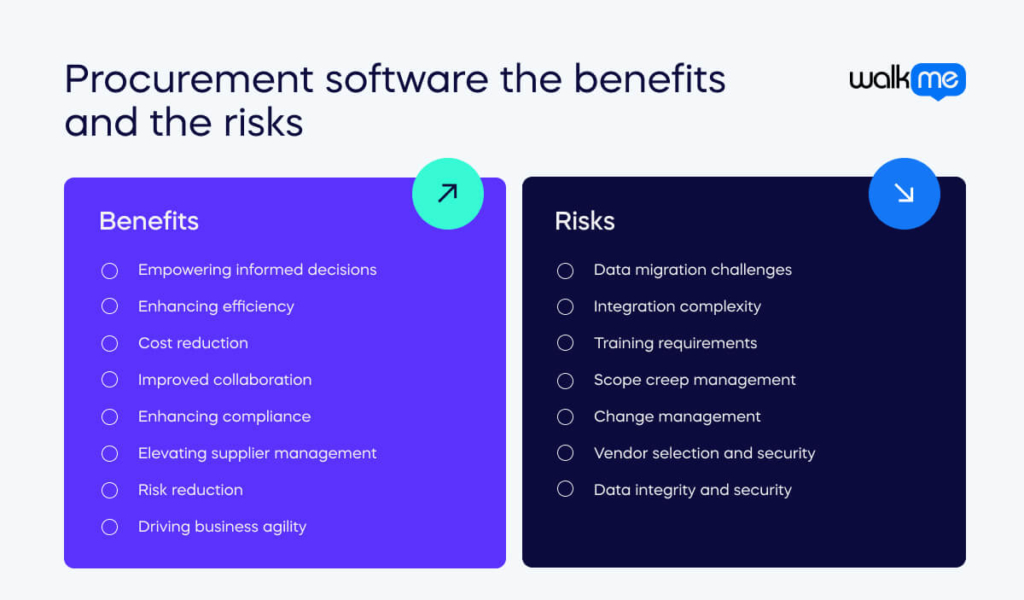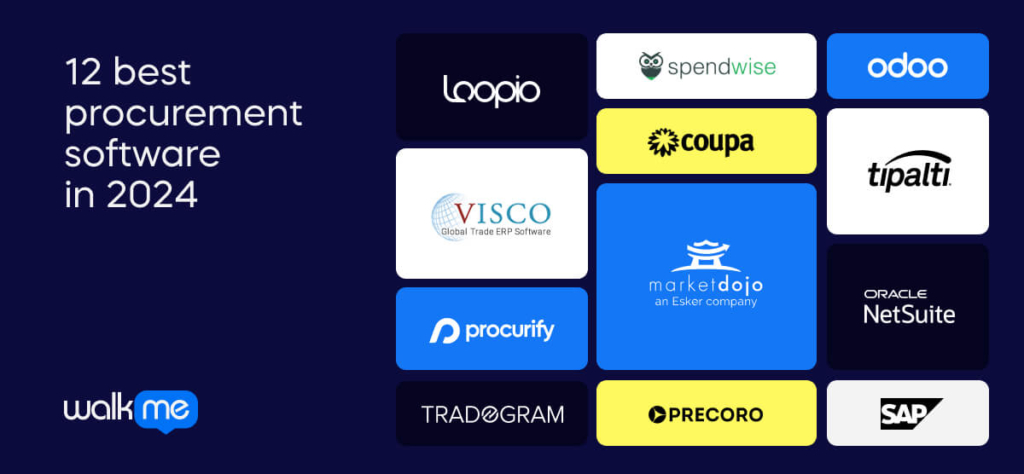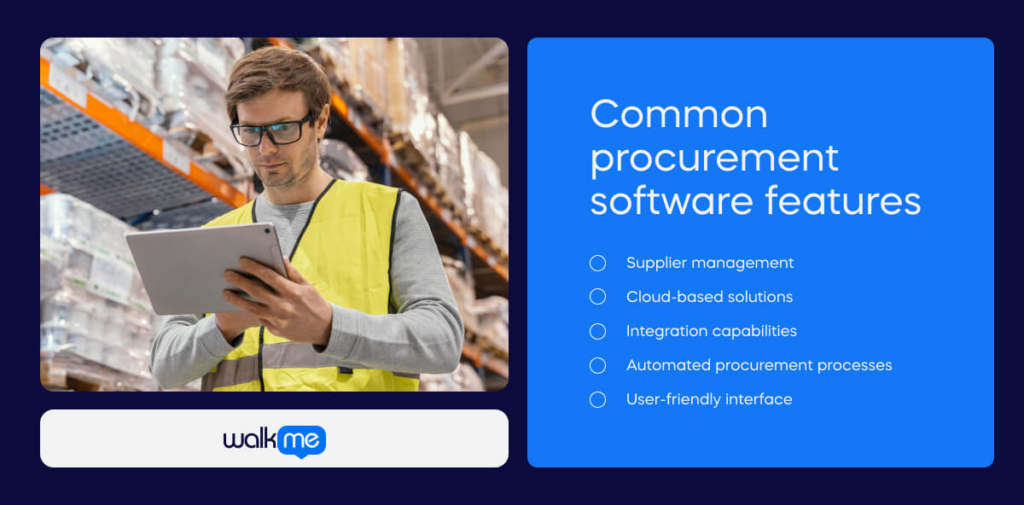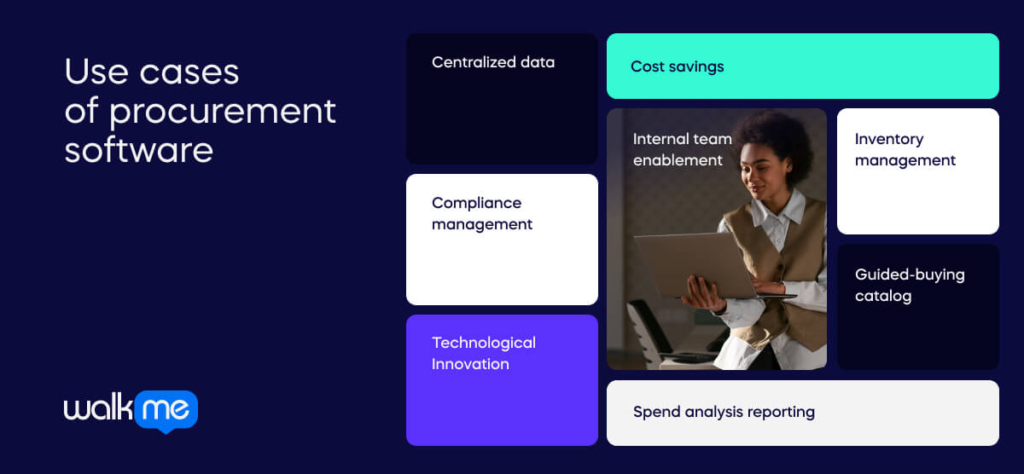Choosing the right procurement platform can be like walking through a minefield. One mistake can result in revenue loss, customer churn, or legal issues.
The challenge goes beyond the sheer number of available digital tools. It is crucial to check factors like deployment options and customization capabilities.
Among these considerations, one should not forget about one’s own business needs. When making a decision, you must check your specific requirements. You should also compare them with other potential solutions and consider your budget.
This article will examine the 12 best procurement software vendors for 2024. It will also explain procurement software, its benefits and risks, and its use cases. It will also detail the common features you need when choosing procurement software.

What is procurement software?
Procurement software aims to simplify an organization’s procurement processes. It does this by streamlining and automating them when workable. These processes involve buying, managing orders, controlling inventory, supervising suppliers, and more.
Procurement software provides a centralized and user-friendly solution. It consolidates all relevant information and procedures of the procure-to-pay cycle. Additionally, it offers compatibility with enterprise resource planning (ERP) systems for smooth integration.

12 best procurement software in 2024
1. Tradogram
- G2 rating: 4.0/5 (6)
- Basic, Enterprise & Premium options are available.
Tradogram is a procurement software solution designed to streamline the purchasing process. It is suitable for midsize to enterprise-level companies. It offers features such as requisitions and order management. It also includes supplier management and inventory tracking. Further features include budgeting, financial reporting, contract management, and spending analysis.
Features:
- Supplier management: Centralized database for supplier information, performance tracking, and communication.
- Purchase-to-Pay (P2P): Streamlines the entire procurement cycle from requisition to payment.
- Spend analysis: Provides visibility into spending patterns, enabling data-driven procurement decisions.
- Contract management: Helps manage contract lifecycles, terms, and renewals
2. Odoo
- G2 rating: 4.5/5 (16)
- Plans begin at $24 per app/per user/per month.
Odoo makes managing suppliers and orders a breeze. Its procurement tools can optimize business operations. It does this by minimizing stock levels and preventing stock-outs. Odoo’s intuitive features allow for easy change of stock quantities. Do this using reordering rules and automatic routes (replenish on order). Businesses can keep track of product pricing and shipping details. You can do this by importing vendor price lists and lead times.
Features:
- Inventory Tracking and Management: Monitors the quantity of resources to ensure proper supply.
- Inventory Level Monitoring: Keeps an eye on product stock levels.
- Invoice Lifecycle Management: Handles creation, processing, verification, and execution of invoices.
- Purchase Order Oversight: Generates, sends, and tracks orders and their statuses.
- Quoting and Estimation: Generates quotes or estimates for customers.
- Receiving and Warehousing: Administers the process from initial load receipt to stocking.
3. Visco
- G2 rating: 4.2/5 (6)
- Contact Visco for pricing information.
VISCO is perfect for small to mid-sized businesses. It provides comprehensive solutions for all departments. These include order tracking, inventory management, financial reporting, and import compliance.
Notable features include automated document creation and task and shipment notifications. The app also includes a Product Positioning Tool for tracking inventory. The mobile sales app provides access to customer information and product catalogs. This makes purchasing and selling easier with automatic unit conversion.
Features:
- Resource Inventory Oversight: Supervises the quantity of resources available to ensure optimal supply levels.
- Stock Monitoring: Keeps an eye on product stock levels.
- Receiving and Warehouse Organization: Manages the process from initial receipt to final stocking.
- Invoice Lifecycle Handling: Manages the creation, processing, verification, and execution of invoices.
- Purchase Order Monitoring: Creates, sends, and monitors orders and their statuses.
- Contract and License Tracking: Tracks, stores, and accesses client/customer contracts.
4. Loopio
- G2 rating: 4.7/5 (583)
- Contact Loopio for pricing information.
Loopio offers RFP response management software tailored to mid-sized to large organizations. The platform empowers companies to enhance and expand their response capabilities across various documents, such as DDQs and security questionnaires.
Features:
- Efficient Knowledge Gathering: Uses the collective knowledge within your organization to answer queries.
- Scalable Response Management: Streamlines and scales your response management process. This ensures efficiency and effectiveness across RFPs, RFIs, DDQs, and security questionnaires.
- Centralized Content Library: You can save RFP answers in an up-to-date content library. This saves a team valuable time.
- Automated Task Management: Loopio automates manual, low-impact tasks in the response process. This allows a team to focus on crafting exceptional responses.
- Streamlined Collaboration: Responding to questions becomes a simplified process for all involved.
5. Procurify
- G2 rating: 4.6/5 (200)
- Contact Procurify for pricing options.
Procurify is a cloud-based purchase order approval workflow software. It tracks orders from creation to final delivery. It offers automated approval flows, real-time budget commitments, and a custom catalog. These features streamline requesting, approving, receiving, and reconciling orders. Procurify simplifies adoption for all team members. This prevents constant process corrections and invoice chasing for finance and operations.
Features:
- Order Oversight and Tracking: Initiates, dispatches, and tracks orders.
- Resource Inventory Supervision: Monitors and manages the quantity of resources available.
- Invoice Lifecycle Management: Handles the creation, processing, verification, and execution of invoices.
- Document Approval Automation: Streamline and manage evaluating and authorizing documents.
- Budget Creation and Prediction: Develop budgets utilizing historical data and future projections.
- Spending Limit Enforcement: Establish allowances and ensure employees adhere to allotted spending amounts.
6. Tipalti
- G2 rating: 4.5/5 (224)
- Pricing starts at $129 for one user per month
Tipalti provides a comprehensive payables automation solution. It integrates all aspects of the payment workflow into a single platform. Designed for finance departments, Tipalti streamlines supplier onboarding. It also assists with tax compliance, procurement, fraud detection, and financial controls. Next, it can automate payment reconciliation, ERP integration, and card spend management.
Features:
- Approval Workflow Automation: Streamlines and oversees the evaluation and authorization of documents.
- Invoice Lifecycle Management: Handles the creation, processing, verification, and execution of invoices.
- Purchase Order Oversight: Generates, sends, and monitors orders.
- Expenditure Analytics: Assesses and unveils patterns in spending activities.
- Contract and License Tracking: Monitors, archives, and retrieves client and customer contracts.
- Receipt and Inventory Management: Administers the process from the start until placement.
7. NetSuite
- G2 rating: 4.0/5 (3136)
- Contact NetSuite for a quote.
NetSuite Procurement simplifies vendor management and purchasing operations. Sending orders to authorized suppliers and using pre-arranged contracts ensures timely procurement. Transparent monitoring of expenses and vendor performance improves communication.
The procurement dashboard manages all procurement data. This includes records, expenditures, and performance assessments. Growing companies of all sizes can use it. This provides for startups and small and mid-sized enterprises. They use it to automate operations and. gain real-time insights into operational and financial metrics.
Features:
- Sourcing Management: Allows employees to select vendors that match their needs.
- Purchase Tracking: Monitors purchases to maintain inventory. Understanding pending orders, quantities, and expected delivery times facilitates inventory level optimization.
- Invoice Management: Handles vendor payments. It does this by automating receipt of ordered items and scheduling timely payments.
- Vendor Relations Management: Oversees all aspects of vendor relationships. NetSuite vendor management streamlines supplier communication and tracks vendor performance.
8. Spendwise
- G2 rating: 4.8/5 (46)
- Contact Spendwise for pricing information.
Spendwise can streamline the management of purchase orders, bills, and expenses. Users can submit orders for approval, before sending them to vendors. Additionally, users can track items and bills they have received from their vendors.
Features:
- Initiating Purchase Requests: Create requests and submit them for approval.
- Generating Purchase Orders: Create orders and send them to vendors.
- Tracking Order Receipts: Track received items corresponding to orders.
- Managing 3-Way Matching: Ensure accuracy by tracking billed items from vendors.
- Customizing User Roles: Define user permissions and system access.
- Monitoring Spending: Track spending by category, department, and project.
- Creating and Monitoring Budgets: Establish budgets and track spending against them.
- Generating Reports: Run and save reports in PDF or Excel formats.
- Developing Many Dashboards: Create dashboards for easy monitoring of spending activities.
- Exporting Data: Export transactional and other data to Excel.
- Implementing Approval Limits and Workflows: Establish approval limits and workflows for spending control.
- Optional Inventory Management: Track inventory balances if applicable.
9. Coupa
- G2 rating: 4.2/5 (490)
- Contact Coupa for pricing information through their website.
The Coupa platform enables businesses to manage to spend, facilitating resilience and growth. Coupa provides centralized management for requests and approvals and simplified payments. It integrates with your ERP system, ensuring compliance and maximizing spending control.
Features:
- Streamline the Payment Process: Covers a wide range of features from spend analysis to automatic reconciliations.
- Enhance Supplier Collaboration: Engages with transacting suppliers and onboards with no fees.
- Manage Risk: Mitigates risks through comprehensive risk management across the supply chain.
- Improve Travel and Expense Management: Optimizes booking processes and streamlines expense reporting.
- Maximize Supply Chain Efficiency: Utilizes digital twin modeling. It does this to optimize the entire supply chain and transition.
10. Market Dojo
- G2 rating: 4.6/5 (6)
- Free Plan, Full License Monthly & Pay as you host options are available.
Market Dojo allows businesses to digitize and streamline sourcing and supplier management processes. It offers more flexibility compared to traditional software and has no implementation fees. Users have a self-service platform to manage costs, mitigate risks, and centralize data. The modules cover sourcing, supplier onboarding, contract management, and opportunity analysis.
Features:
- Supplier Relationship Management: Oversees different facets of supplier relationships, including history tracking.
- Catalog Management and Categorization: Develops and maintains a digital catalog of products/services.
- Contract and License Tracking: Monitors, archives, and retrieves client/customer contracts.
- Sourcing Strategy Development: Negotiates optimal prices and selects suitable vendors for various purchases.
- Quoting and Estimation Generation: Produces quotes or estimates for customers.
- Automated Approval Process Management: Streamlines and oversees the evaluation and authorization of requests.
11. SAP Ariba
- G2 rating: 4.1/5 (500)
- Contact SAP Ariba for further pricing information.
SAP Ariba automates the management of the purchasing lifecycle for goods and services. This streamlines workflows and expedites approvals while eliminating errors and exceptions. By improving procurement efficiency, users can handle more spending and meet demands. This allows organizations to increase their flexibility, responsiveness, and financial efficiency.
Features:
- Automation: Generates requisitions, streamlines invoicing, synchronizes catalogs, and tracks procurement processes for compliance.
- Integration with ERP Systems: Allows the user to share data across the business.
- Procure-to-Pay: Unifies procurement processes within a single platform. These include sourcing, automating tasks, and streamlining auditing.
- Supplier Management: Mitigates supplier risk through automated onboarding and performance tools.
12. Precoro
- G2 rating: 4.7/5 (138)
- Pricing begins at $39 per month per user (for less than or equal to 20 users). For more than 20 users, please contact Precoro.
Precoro is a cloud-based solution that streamlines procurement processes by automating tasks and centralizing purchasing procedures. It provides streamlined approval processes, budget oversight, and expense tracking. Users can manage purchase orders, suppliers, and inventory. Precoro integrates with ERP systems and other tools, ensuring streamlined processes and enhanced security. The platform offers a user-friendly interface and individualized help.
Features:
- Purchase Order Administration: Initiates, dispatches, and monitors orders and their progress.
- Invoice Handling: Manages the creation, processing, verification, and execution of invoices.
- Budget Creation and Projection: Develops budgets utilizing historical data and future projections.
- Resource Inventory Oversight: Monitors and manages the quantity of resources available.
- Document Approval Automation: Streamlines and manages evaluating and authorizing requests.
- Supplier Relationship Management: Handles various aspects of the relationship with suppliers.
Common procurement software features

Here are common procurement software features to look for when choosing a solution:
Supplier management
Efficient supplier management is vital for procurement platforms. This requires identifying, onboarding, managing, and analyzing suppliers in various departments and categories. Advanced procurement suites enable easy supplier onboarding and performance measurement for accurate tracking.
Cloud-based solutions
In today’s workplaces, procurement solutions need to be omnichannel and always accessible. Cloud-based procurement software offers scalability, cost-effectiveness, and remote accessibility.
Integration capabilities
An ideal procurement platform integrates with third-party tools such as accounting systems. This integration eliminates data redundancy and human errors. It does this by allowing the direct import and export of data. Flexible management tools ensure data synchronization without manual intervention.
Automated procurement processes
Procurement software automates various procurement processes. This includes supplier qualification, approval workflows, and budget monitoring. This allows organizations to solve issues and enhance efficiency.
User-friendly interface
Select procurement software with an intuitive user interface (UI). A well-designed UI allows for efficient navigation and access to essential information. This improves productivity and user satisfaction.
What are the benefits of procurement software?
There are various benefits of procurement software, such as:
Empowering informed decisions
Procurement software helps businesses gain data and insights for smart purchasing decisions. It provides a complete understanding of procurement processes through consolidating data. This empowers more strategic and data-oriented decision-making.
Enhancing efficiency
The implementation of procurement software enhances efficiency within an organization. It minimizes manual interventions and eliminates the need for paperwork. This reduces errors in the process. This efficient approach speeds up procurement and automates routine tasks. This then enables procurement professionals to concentrate on strategic activities.
Cost reduction
Procurement software helps reduce costs by automating manual tasks. Automating tasks like requisitions and order processing can reduce labor costs. Furthermore, automation helps decrease errors, resulting in reduced costs.
Improved collaboration
Effective collaboration portals in procurement software align internal and external communication. It creates a centralized platform to access information. This keeps all stakeholders informed and aligned, improving collaboration and efficiency.
Enhancing compliance
Procurement software plays a vital role in increasing compliance in businesses. Automating oversight of policies and procedures allows alignment with regulations and internal guidelines. This technology reduces the risk of non-compliance. It also promotes a standardized and transparent procurement setting.
Elevating supplier management
Procurement software is crucial for enhancing supplier management in businesses. It serves as a centralized platform for overseeing and nurturing supplier relationships. This supports informed decision-making with comprehensive performance tracking and metrics.
Risk reduction
You can strengthen the risk management strategy by using procurement software. This is because it identifies and resolves potential issues. These include supplier fraud or product quality concerns.
Driving business agility
The use of procurement software enhances business agility. This enables quick response to market and customer changes. It also allows procurement teams to make informed decisions. It does this by streamlining workflows and providing real-time insights. This helps organizations seize emerging opportunities.
What are the risks of procurement software?
But, you need to be aware of the various risks of procurement software:
Data migration challenges
The process of migrating data into a new centralized system presents several difficulties. One of the main difficulties is finding and extracting data from different systems. This is the case when exporting data is not supported. Additionally, data quality issues such as duplicates and obsolete data need thorough cleaning. This demands significant time, resources, and expertise.
Integration complexity
Integrating procurement software with current systems and processes is complex and time-consuming. You may need custom development. This results in increased implementation costs and possible compatibility problems. Lack of dedicated resources and effective management during implementation can also be an issue.
Training requirements
Employee learning plays an important role in improving software use. Still, training can be a significant drain on time and resources. This can be the case for larger organizations. Insufficient change management and user preparation can lead to resistance. It can also lead to reduced productivity after implementation.
Scope creep management
Scope creep, the addition of new software features beyond the original scope, can inflate project costs. Effective project management and a deployment plan are crucial to prevent this.
Change management
User resistance to change can be a barrier to the successful implementation. This is where effective change management strategies become useful. These include training, onboarding, and communication.
Vendor selection and security
Choosing the correct vendor is essential. This will help cut risks like data breaches and system compatibility problems. You can do this by checking a vendor’s reputation, track record, and security measures.
Data integrity and security
It is crucial to put in place strong security measures. This is necessary to safeguard sensitive information during migration. The new software must integrate with existing systems. You should do this to maintain data integrity and provide interoperability. You can do this to prevent usability issues and guarantee business continuity.
Use cases of procurement software

The various ways that you can use procurement software for your organization include:
- Centralized data: Procurement software centralizes all procurement data. This offers real-time visibility into spending, contracts, and supplier management.
- Automation: Procurement software automates tasks like purchase orders, invoicing, and contract management. This reduces manual efforts and increases efficiency.
- Compliance management: These tools ensure compliance with company policies and legal requirements. It does this through features like compliance tracking and automated procurement contract management.
- Streamlined purchase requests: Users can create and submit requests. This assists in reducing the time and effort involved in the process.
- Faster approval workflows: Automated approval workflows speed up the approval process for requests. This helps reduce delays and ensures timely procurement.
- Cost savings: Procurement management tools offer insights into spending patterns and cost-saving opportunities. This helps companies save money on purchases.
- Internal team enablement: Procurement software enables teams to submit purchase requisitions for approval. It can also send this to the appropriate personnel.
- Purchase order management: It creates and submits orders. It also helps manage communication with suppliers for order confirmations, cancellations, or alterations.
- Inventory management: The software maintains an inventory of goods to prevent shortages.
- Spend analysis reporting: Procurement software provides spend analysis reports based on real-time data. This offers insights for improving cost savings and maximizing profits.
- Standardization and administration: It streamlines standardization and administration across many platforms. This ensures consistency in procurement processes.
- Enforcement of purchasing policies: Automated enforcement of purchasing policies and internal controls.
- Guided-buying catalog: A guided-buying catalog allows teams to purchase from pre-approved suppliers.
- Supplier contract management: It manages supplier contracts. This helps in ending reminders for contract renewals and negotiations.
Next steps for procurement software
Procurement software is crucial for organizations that want to improve goal attainment. It can also boost team productivity, and cut inefficiencies associated with manual processes.
Employees can use this software to get exactly what they need. They can also keep track of expenses and budgets in a centralized system. Procurement software streamlines purchasing by consolidating vendors onto one platform, reducing errors. By automating processes, procurement software allows your team to focus on operational improvements.
In the end, it boosts visibility and improves controls. It also streamlines the purchasing process, making life easier for employees and vendors. With a digital adoption platform (DAP), organizations can provide end-users with contextual guidance and offer self-help support. This improves the effectiveness of procurement applications and digital processes.

